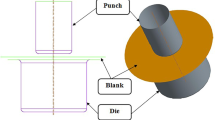Abstract
Forging is the process whereby the shape of a workpiece (usually metallic) is changed by pressing or hammering the workpiece between two or more dies, with or without the application of heat. Complex shapes are usually forged from the original stock material in a number of stages. Quite often, the dies for several stages are grouped together in the same forging press or hammer, the workpiece being transferred from die cavity to die cavity (manually or by an automatic mechanism) in between successive blows of the machine.
Access this chapter
Tax calculation will be finalised at checkout
Purchases are for personal use only
Preview
Unable to display preview. Download preview PDF.
Similar content being viewed by others
References
Yu GB, Dean TA. A CAD/CAM package for hammer forging dies. In: Proceedings 25th Machine Tool Design Research Conference, Birmingham, April 1985. Macmillan, London, 1985, pp 459–464
Choi SH, Sims P, Dean TA. A complete CAD/CAM package for hammer forging dies. Proceedings 25th Machine Tool Design Research Conference, Birmingham, April 1985. Macmillan, London, 1985, pp 451–458
Gokler MI, Dean TA, Knight WA. Computer aided die design for upset forging machines. Proceedings 11th NAMRC Conference, 1983, pp 217–223
Rao SS. The finite element method in engineering, Pergamon, 1982
Pillinger I. The prediction of metal flow and properties in three-dimensional forging using the finite-element method. PhD thesis, University of Birmingham, 1984
Pillinger I, Hartley P, Sturgess CEN, Rowe GW. Finite-element modelling of metal-flow in three-dimensional forming. Int J Num Meth Eng, 1988; 25: 87–97
Rowe GW, Sturgess CEN, Hartley P, Pillinger I. Finite-element plasticity and metalforming analysis. Cambridge University Press, 1990
Hartley P, Sturgess CEN, Dean TA, Rowe GW, Eames AJ. Development of a forging expert system. In: Pham DT (ed) Expert systems in engineering. IFS, Bedford, 1988, pp 425–443
Editor information
Editors and Affiliations
Rights and permissions
Copyright information
© 1991 Springer-Verlag London Limited
About this chapter
Cite this chapter
Pillinger, I., Hartley, P., Sturgess, C.E.N., Dean, T.A. (1991). An Intelligent Knowledge-Based System for the Design of Forging Dies. In: Pham, D.T. (eds) Artificial Intelligence in Design. Artificial Intelligence in Industry Series. Springer, Berlin, Heidelberg. https://doi.org/10.1007/978-3-642-74354-2_13
Download citation
DOI: https://doi.org/10.1007/978-3-642-74354-2_13
Publisher Name: Springer, Berlin, Heidelberg
Print ISBN: 978-3-642-74356-6
Online ISBN: 978-3-642-74354-2
eBook Packages: Springer Book Archive



